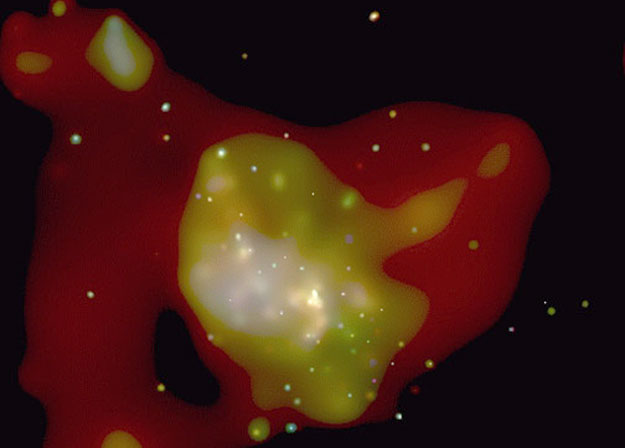
|
Explanation: Why would the center of our Galaxy flicker? Many astronomers believe the only credible answer involves a black hole. During observations of Sagittarius A* with the orbiting Chandra X-ray Observatory, the bright X-ray source at the very center of our Milky Way brightened dramatically for a few minutes. Sagittarius A* is visible as the bright dot near the center of the above image. Since large objects cannot vary quickly, a small source is implicated in the variation. Evidence including the motions of central stars indicates that the center of our Galaxy is a massive place, however, estimated to be over a million times the mass of our Sun. Only one known type of object can fit so much mass in so small a volume: a black hole. This short flicker therefore provides additional evidence that a black hole does indeed reside at our Galaxy's center. If true, the flicker might have been caused by an object disrupting as it fell toward the disruptive monster.
|
January February March April May June July August September October November December |
| ||||||||||||||||||||||||||||||||||||||||||||||||
NASA Web Site Statements, Warnings, and Disclaimers
NASA Official: Jay Norris. Specific rights apply.
A service of: LHEA at NASA / GSFC
& Michigan Tech. U.
Based on Astronomy Picture
Of the Day
Publications with keywords: black hole - Galactic Center - Sgr A
Publications with words: black hole - Galactic Center - Sgr A
See also:
- APOD: 2025 December 3 B Visualization: Near a Black Hole and Disk
- APOD: 2025 September 24 B GW250114: Rotating Black Holes Collide
- APOD: 2025 May 9 B IXPE Explores a Black Hole Jet
- APOD: 2025 May 6 B The Doubly Warped World of Binary Black Holes
- APOD: 2025 May 4 B Spin up of a Supermassive Black Hole
- APOD: 2025 April 14 B The Galactic Center in Radio from MeerKAT
- APOD: 2024 November 24 B Journey to the Center of the Galaxy
